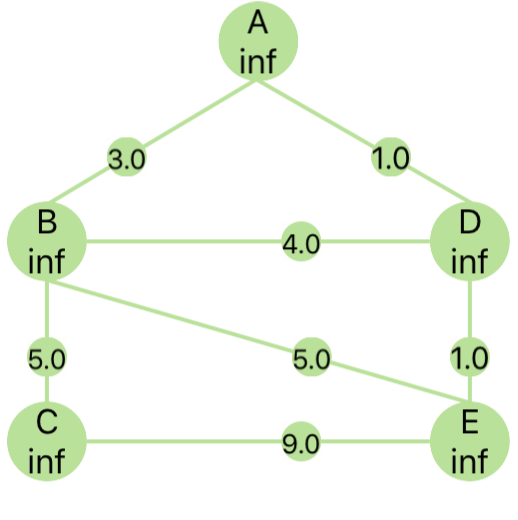推荐学习书目 Learn Python the Hard Way Python Sites PyPI - Python Package Index http://diveintopython.org/toc/index.html Pocoo 值得关注的项目 PyPy Celery Jinja2 Read the Docs gevent pyenv virtualenv Stackless Python Beautiful Soup 结巴中文分词 Green Unicorn Sentry Shovel Pyflakes pytest Python 编程 pep8 Checker Styles PEP 8 Google Python Style Guide Code Style from The Hitchhiker's Guide
这是一个创建于 2422 天前的主题,其中的信息可能已经有所发展或是发生改变。
关于这个队列实现的版本中:
为什么每次要从队列中选取距离最小的顶点出发?而不是按照广度优先的顺序?
代码如下:
def dijkstra1(graph, start): distances = {vertex: float('inf') for vertex in graph} distances[start] = 0 visited = set() queue = list(graph.keys()) while queue: vertex = min(queue, key=lambda vertex: distances[vertex]) queue.remove(vertex) visited.add(vertex) for neighbor in graph[vertex]: if distances[vertex] + graph[vertex][neighbor] < distances[neighbor]: distances[neighbor] = distances[vertex] + graph[vertex][neighbor] if neighbor not in visited: queue.append(neighbor) return distances 我试着用广度优先搜索,发现也不影响实际结果,而且性能和用最小堆实现的差不多
from collections import deque def dijkstra2(graph, start): distances = {vertex: float('inf') for vertex in graph} distances[start] = 0 visited = set() queue = deque([start]) while queue: vertex = queue.popleft() visited.add(vertex) for neighbor in graph[vertex]: if distances[vertex] + graph[vertex][neighbor] < distances[neighbor]: distances[neighbor] = distances[vertex] + graph[vertex][neighbor] if neighbor not in visited: queue.append(neighbor) return distances 测试代码
g = { 'A': {'B': 3, 'D': 1}, 'B': {'A': 3, 'C': 5, 'D': 4, 'E': 5}, 'C': {'B': 5, 'E': 9}, 'D': {'A': 1, 'B': 4, 'E': 1}, 'E': {'B': 5, 'C': 9, 'D': 1} } print(dijkstra(g, 'A')) 测试图

第 1 条附言 2019-02-23 22:44:30 +08:00
知道区别了,@66450146 说的队,如果不给定终点,两种方法计算所有的顶点是没有区别的。
但如果要计算起点指定终点的最短路径,我的 BFS 算法中,对于当前顶点,路径不一定是最短路径,需要访问完所有的顶点才能确定最短路径,而 Dijkstra 算法对于当前顶点,走的就是最短路径,不用计算所有顶点。
最终代码如下:
from heapq import heappush, heappop def dijkstra(graph, source, destination=None): distances = {vertex: float('inf') for vertex in graph} distances[source] = 0 priority_queue = [(distances[source], source)] precursors = {} while priority_queue: distance, vertex = heappop(priority_queue) if distance == distances[vertex]: if destination == vertex: break for neighbor in graph[vertex]: if distances[vertex] + graph[vertex][neighbor] < distances[neighbor]: distances[neighbor] = distances[vertex] + graph[vertex][neighbor] heappush(priority_queue, (distances[neighbor], neighbor)) precursors[neighbor] = vertex if destination: precursor = destination path = [] while precursor: path.append(precursor) precursor = precursors.get(precursor) return distances[destination], path[::-1] paths = [] for precursor in precursors: path = [] while precursor: path.append(precursor) precursor = precursors.get(precursor) paths.append(path[::-1]) return distances, paths 第 2 条附言 2019-02-24 02:33:32 +08:00
刚才看 Bellman-Ford 算法,才发现我写的 bfs 队列版本竟然和 SPFA 的思路是一样的,不过这里没有检测环路,因此对于只有正权边的图是适用的。
1 MrAMS 2019-02-23 20:05:50 +08:00 Dijkstra 本质上其实就是个贪心 每次要从队列中选取距离最小的顶点出发保证了每一步的最优 (广度优先搜索出来的,因为数据特殊?) |
3 Fulcrum 2019-02-23 20:13:56 +08:00 via Android 没记错是因为 P(n)+p(n+1)>=p(x)+p(n+1)?去年学的运筹,基本忘了。。。 是反证法证明的。 |
4 Fulcrum 2019-02-23 20:14:15 +08:00 via Android 没记错是因为 P(n)+p(n+1)>=p(x)+p(n+1)?去年学的运筹,基本忘了。。。 是反证法证明的,记得很短。 建议找本运筹学看看,有证明的 |
5 66450146 2019-02-23 21:15:26 +08:00 这是使用场景不合适,Dijkstra 更适合你只关心从 A->E 的距离,而不关心到其他节点距离的时候。具体的做法就是在中间提早 return,可以证出来 Dijkstra 得出的一定是最优解,而 BFS 的做法不一定 def dijkstra1(graph, start, end): distances = {vertex: float('inf') for vertex in graph} distances[start] = 0 visited = set() queue = list(graph.keys()) while queue: vertex = min(queue, key=lambda vertex: distances[vertex]) queue.remove(vertex) visited.add(vertex) for neighbor in graph[vertex]: if distances[vertex] + graph[vertex][neighbor] < distances[neighbor]: distances[neighbor] = distances[vertex] + graph[vertex][neighbor] if neighbor == end: return distances[neighbor] if neighbor not in visited: queue.append(neighbor) |
6 66450146 2019-02-23 21:16:52 +08:00 格式乱了,就是加了一个 if ... return 而已,两种做法对于: g = { 'A': {'B': 1, 'F': 99}, 'B': {'A': 1, 'C': 1}, 'C': {'B': 1, 'D': 1}, 'D': {'C': 1, 'E': 1}, 'E': {'D': 1, 'F': 99}, 'F': {'A': 99, 'E': 99} } 得出来的结果是不一样的 |
